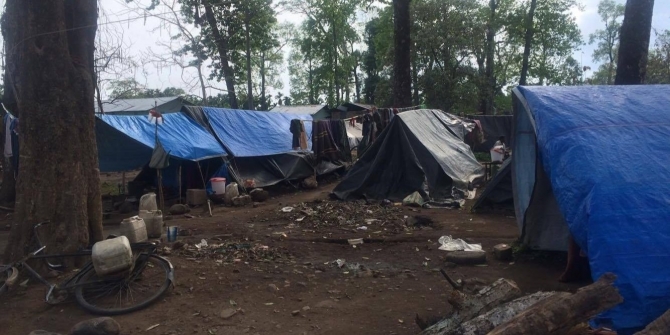 Despite the advent of digital solutions designed to promote greater financial access, large numbers of women in Bangladesh remain without access to financial services. Anjali Sarker (Atlantic Fellow for Social and Economic Equity at the International Inequalities Institute, LSE) explains why solving longstanding problems of financial exclusion in a country with one of the highest gender gaps in financial access will take more than the introduction of banking apps and financial platforms.
Despite the advent of digital solutions designed to promote greater financial access, large numbers of women in Bangladesh remain without access to financial services. Anjali Sarker (Atlantic Fellow for Social and Economic Equity at the International Inequalities Institute, LSE) explains why solving longstanding problems of financial exclusion in a country with one of the highest gender gaps in financial access will take more than the introduction of banking apps and financial platforms.
Never before have so many people had access to banking. In 2017, 69 per cent of the world’s adults – some 3.8 billion people – had a bank account or a mobile money account, up from just 51 per cent in 2011, according to the latest World Bank Global Findex Database. But while financial inclusion is on the rise overall, the financial access gender gap is as large as it was in 2011; in developing economies, the average gap between men’s and women’s access to financial services is 9 percentage points, and in some cases, has even increased. Bangladesh is a sobering example: between 2014 and 2017, its gender gap in financial access grew significantly, and at 29 percentage points, is now one of the largest gender gaps in the world.
While many believe that digital solutions, and in particular “mobile money” facilitated by the spread of mobile phones, will solve the longstanding problem of financial exclusion, tackling the problem is more complex than it first might appear. Millions of unbanked women are still struggling to navigate phone menus – or even to access them: in Bangladesh, 45 per cent of adult women do not own a mobile phone. The women most likely to be excluded from the financial system – poor, rural and illiterate or semi-literate – are in no position to benefit from the mobile money revolution. So how far can advances in technology really take us?
 Photo: A Family in Bangladesh | Credit: Unsplash
Photo: A Family in Bangladesh | Credit: Unsplash
In today’s world, it is hard to resist the temptation to look for an app-shaped solution to every problem. Major players in the financial system are channelling significant resources into tech-based services and digital platforms. As we enter the era of the fourth industrial revolution, the drive to upgrade existing services to e-services makes sense. However, presenting digital solutions to a population that is not yet ready for them inevitably means the further exclusion of society’s most marginalised.
Just as the same knife will be used differently by a surgeon and a child, new financial technology will have a very different impact on the world’s haves and have-nots, and almost inevitably cuts across the line dividing the two. It is naive to think that poor women in patriarchal societies who have been historically excluded from accessing financial services will be empowered by digital innovations alone. Even women offered access to such services may choose not to use them for a whole range of reasons, from perceived lack of relevance to the potential users’ own lack of readiness.
Inevitably, literacy – not only in its conventional sense, but financial and digital literacy too – are key factors in an individual’s readiness to make use of digital financial services. More than 36 per cent of rural women over the age of 15 in Bangladesh are illiterate, and their financial and digital literacy levels are likely to be every bit as low. According to GSMA’s Mobile Gender Gap report on phone use in low- and middle-income countries, a staggering 48 per cent of women who do not own a mobile phone say that difficulties in reading and writing are the main barrier to ownership. These women, who are in many cases barely able to use a simple feature phone, are likely to self-exclude from digital financial services or quickly lose interest unless they have one-on-one support through the steep learning process. Similar arguments can be made regarding the lack of relevance of such services to marginalised women. Unless digital financial services are meaningfully integrated in women’s lives, one or two occasional transactions will not be sufficient to turn them into mobile money users.
In the era of blockchain, Bitcoin and other fintech buzzwords, we cannot forget the non-tech, non-glamorous parts of the much-heralded shift to digital finance. It is time to face the thorny question: what problem, exactly, is technology solving for the world’s unbanked women? What solution lies in an app for an impoverished woman who cannot read, doesn’t own a phone, and who may risk a beating from her husband if he finds out she has opened a mobile money account without his permission?
Technology may well be the shiniest new tool in the financial toolbox, but it is not, on its own, a universal fix. Rather than focusing exclusively on creating digital solutions and expecting everyone – women and men, rich and poor, rural and urban, literate and illiterate – to adapt to them, we must commit to ensuring that such advances work for all. Otherwise, the new world of banking apps and financial platforms may be remarkable more for its ability to foster exclusion and increase inequality than enabling bill payments at the swipe of a screen.
This article gives the views of the author, and not the position of the South Asia @ LSE blog, nor of the London School of Economics. Please read our comments policy before posting.
 Anjali Sarker is an Atlantic Fellow for Social and Economic Equity at the International Inequalities Institute, London School of Economics. @anjalisarker
Anjali Sarker is an Atlantic Fellow for Social and Economic Equity at the International Inequalities Institute, London School of Economics. @anjalisarker







